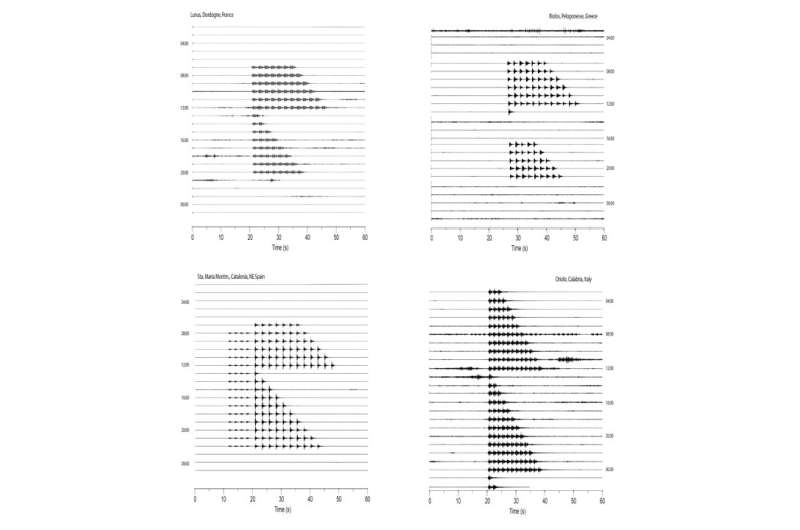Seismic recordings with bell ringing signals in four European locations to mark the passage of time: Lunas (France), Riolos (Greece), Sta. María de Montmagastrell (Spain) and Oriolo (Italy). Each plot corresponds to one day. Each trace represents the same minute at every hour on that day. Credit: Jordi Díaz (ICTJA-CSIC)
A new study made by Jordi Díaz, researcher at Institute of Earth Sciences Jaume Almera of the Spanish National Research Council (ICTJA-CSIC), has compared the different types of bell ringing to indicate the passage of time used in several European countries using recordings of seismometers installed near bell towers. The study, which has been published recently in the Journal of Seismology, describes the characteristics of the seismic signal recorded by stations installed close to four churches from Greece, France, Italy and Spain. The work reflects the existing differences in traditions still active in Europe to mark the hours with bell ringing.
According to Jordi Díaz, one of the objectives of this study is to show "that bridges can be built between very different scientific disciplines, such as seismology and social sciences, since the seismic data offers a new tool to study ethnographic aspects related to how the passage of time is marked in different European cultures."
Seismometers are very sensitive instruments. As the main objective of this equipment is to detect seismic waves generated by distant and local earthquakes, the preferred locations for the stations are quiet areas in order to acquire the cleanest possible signal. Small chapels and churches are often seen as a good option to install seismometers, since most of the time they are not used, and they offer the requirements for security and electrical power. However, the vibrations induced by ringing bells can be recorded by seismometers, and this can affect the data quality.
"The recorded signal contains high values in the upper frequency band, which may indicate that the signals are generated by the acoustic waves produced by the bells and converted to mechanical vibrations close to the seismometers, rather than the vibrations of the bell tower," said Jordi Díaz.
Díaz became interested in analyzing the seismic signal of bell ringing during the deployment of seismic stations carried out in the framework of the TopoIberia-Iberarray project (2007).
"One of the seismometers was installed in the church of Santa Maria de Montmagastrell (Spain). We had been told that the bells wouldn't ring. But we soon learned that it was not the case. When we looked the records, we were able to see clearly the signal of the ringing bell. Since then, I have found here and there other stations that have recorded the same type of signals," said Jordi Díaz.
Díaz collected data from seismometers installed close to the churches of Riolos Kato Achaia (Greece), Oriolo (Italy), Lunas (France) and Santa María de Montmagastrell (Spain). Once the data was processed, the scientist was able to identify some of the characteristics and differences in how each church marked the passage of the hours. Díaz could identify, for instance, the periods during which the bells remained active and inactive, since in France, Greece and Spain, the chimes during nigh time were suppressed. The researcher also determined the patterns and the intervals between bell strokes in each particular case.
In the Greek case, for example, hourly announcements are suppressed from 13:00 to 17:00, probably to preserve the rest time after lunch. In the French case, according to the recorded signal, the medieval tradition of the Angelus is preserved—three times a day, at 07:00, 12:00 and 19:00, a triple stroke of the bells is repeated three times. In the Spanish case, the particular characteristic is how the quarter-hours are indicated: Smaller ringing bells are played every quarter, and the exact hour bell calls are preceded by four strikes, one for each quarter.
In the Italian example, the seismic signal shows a complex pattern. First, bells ring during night and day time. Second, each quarter-hour is marked by a bell stroke that includes the number of chimes corresponding to the previous hour and the number of smaller strikes corresponding to the quarter. This manner of bell ringing results in a total of 768 bell strikes during a single day.
"The data presented here can be interesting to perform studies analyzing the relationship between acoustic and mechanic waves," said Jordi Díaz.
The researcher also highlights the potential use of this type of signal from a seismological point of view. "These signals may be used, as long as they provide a large number of repetitive sources, to explore changes in the mechanical properties of the subsoil, as it is currently being done with environmental seismic noise."
Díaz considers that this study is also an opportunity to increase the interest of the general public in seismology. "I think that this survey can be used to reach an audience that does not usually worry about seismic records nor Earth Sciences, showing that seismic data can also be used in other scientific disciplines."
More information: Jordi Diaz. Church bells and ground motions, Journal of Seismology (2020). DOI: 10.1007/s10950-020-09935-2
Provided by Institue of Earth Sciences Jaume Almera
























